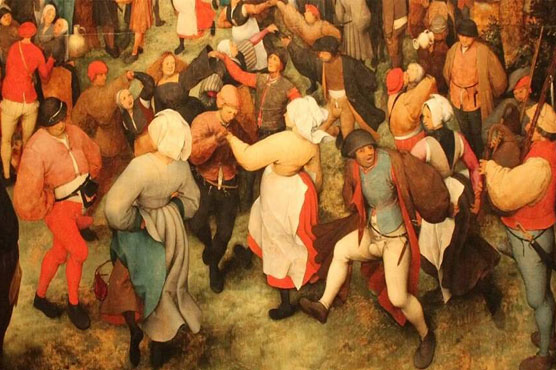Dancing plague of 1518

Dancing plague of 1518
(Web Desk) - The dancing plague of 1518, or dance epidemic of 1518, was a case of dancing mania that occurred in Strasbourg, Alsace (modern-day France), in the Holy Roman Empire from July 1518 to September 1518. Somewhere between 50 and 400 people took to dancing for days.
The outbreak began in July 1518 when a woman began to dance fervently in a street in Strasbourg. By early September, the outbreak began to subside.
Historical documents, including "physician notes, cathedral sermons, local and regional chronicles, and even notes issued by the Strasbourg city council" are clear that the victims danced; it is not known why.
Historical sources agree that there was an outbreak of dancing after a single woman started dancing, a group of mostly young women joined in, and the dancing did not seem to die down. It lasted for such a long time that it attracted the attention of the Strasbourg magistrate and bishop, and some number of doctors ultimately intervened, putting the afflicted in a hospital.
Events similar to this are said to have occurred throughout the medieval age including 11th century in Kölbigk Saxony, where it was believed to be the cause of demonic possession or divine judgment.
In 15th century Apulia Italy, a woman was bitten by a tarantula, the venom making her dance convulsively. The only way to cure the bite was to "shimmy" and to have the right sort of music available, which was an accepted remedy by scholars like Athanasius Kircher.
Contemporary explanations included demonic possession and overheated blood.
Controversy exists over whether people ultimately danced to their deaths. Some sources claim that for a period the plague killed around fifteen people per day, but the sources of the city of Strasbourg at the time of the events did not mention the number of deaths, or even if there were fatalities. There do not appear to be any sources contemporaneous to the events that make note of any fatalities.
The main source for the claim is John Waller, who has written several journal articles on the subject, and the book A Time to Dance, a Time to Die: The Extraordinary Story of the Dancing Plague of 1518.
The sources cited by Waller that mention deaths were all from later accounts of the events. There is also uncertainty around the identity of the initial dancer (either an unnamed woman or "Frau Troffea") and the number of dancers involved (somewhere between 50 and 400). Of the six chronicle accounts, four support Lady Troffea as the first dancer.


